A rifle attributed to Andrew Fitchthorn. The forestock and every thing on
it is a replacement but all else is original to the rifle. An especially
nice lock.
Of paticular interest is the bent over toeplate. This is a device used by
Fitchthorn to protect the toe. There is no toeplate. Shrinkage has pulled
the turn away from the stock. I suspect it looked much neater originally.
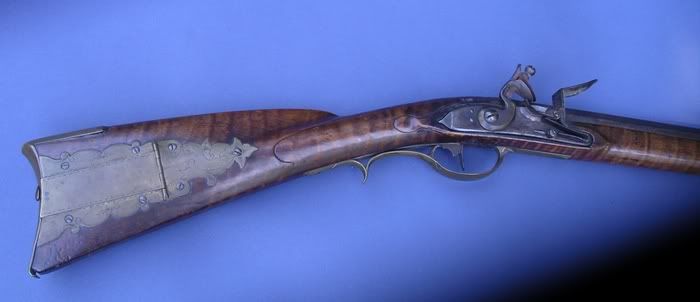
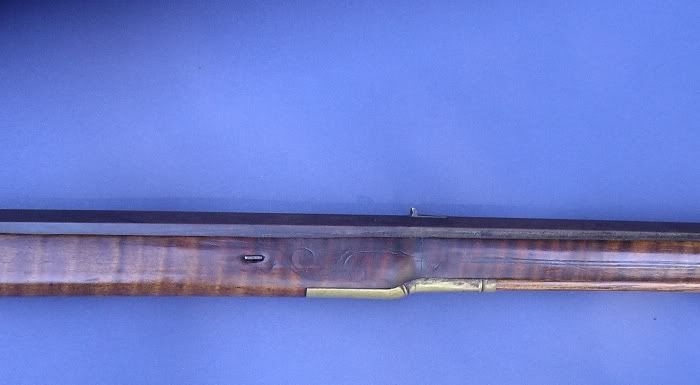

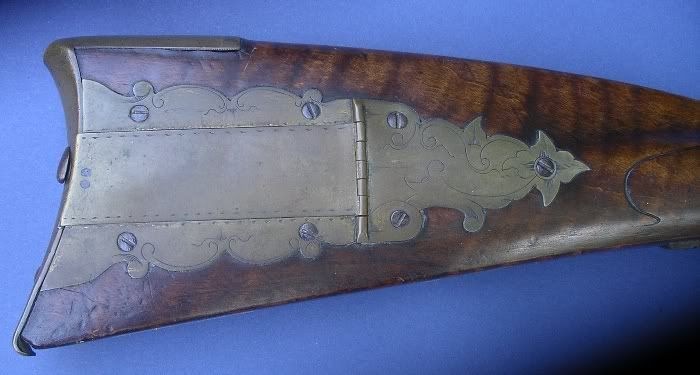
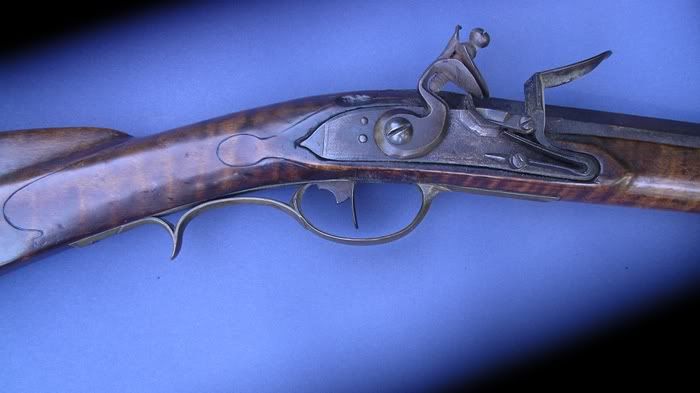
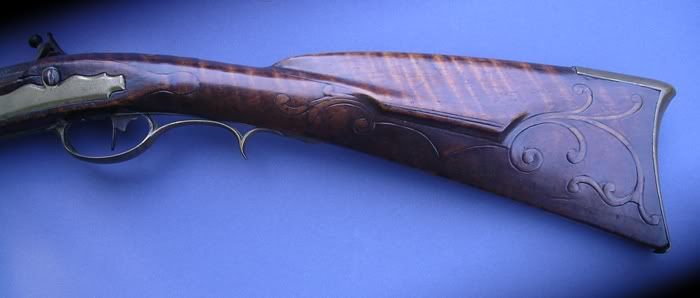
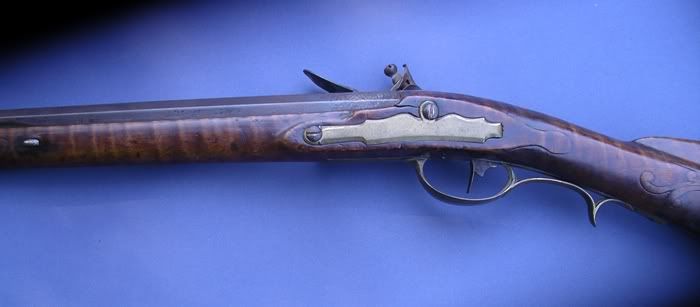
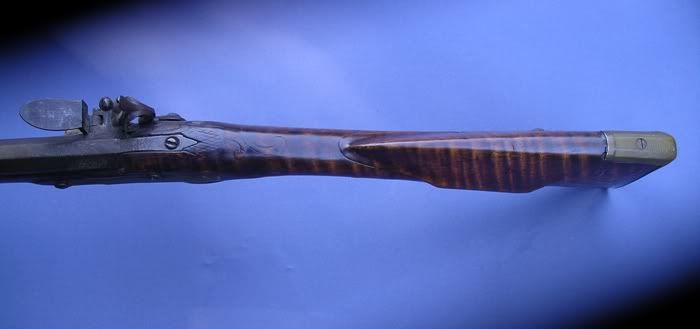
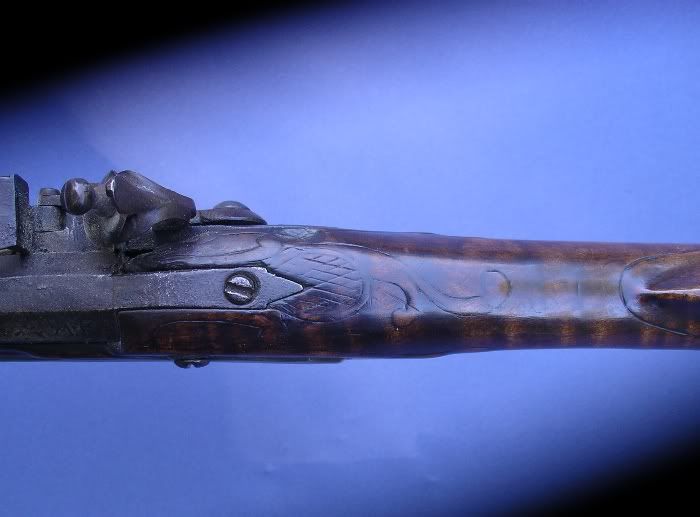
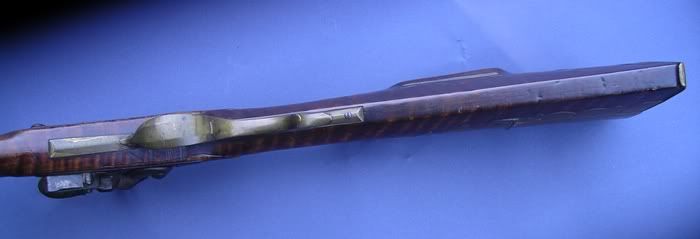

Comments:
This certainly appears to be an Andrew Figthorn rifle and perhaps one of his earlier rifles. The composition of architecture, carving and engraving is very good. The gun was well used and the restoration is very acceptable; a nice job! The 'as found' condition has been preserved and the restoration has been balanced against that. Some stats would be helpful, by the way.
The bent over toe plate is most likely due to being dropped and the wood broken away. I can't remember seeing any rifle that was made with that feature. Not having a toe plate made the nexus of wood and metal somewhat weaker, and subject to breakage.
---------------------------------------------------------------------------------------------
The bent-over butt plate, to create a toe wear area, is a quirky thing that Figthorn occasionally did. The other Figthorn in the library has the same feature. I think Figthorn was the only one that did this.
----------------------------------------------------------------------------------------------
It's a decent Fitchthorn with representative patchbox and understated yet graceful raised carving. The restoration does not detract from the gun, nor give viewers a false sense of what a Fitchthorn looks like. I find the bent toe an interesting detail on this rifle, as referenced by Frank in the last response. The gun should go to the museum.
Upon close observation of this gun and the other in the virtual museum, it appears the tip of the toe has been broken off, rather than cut off by Fitchthorn. I base this on what appears to be uneveness, and slight length differences, between the two small flat sides created on the toe where the butt tip is missing and the butt plate wraps around. I looked in Kindig, and a Fitchthorn gun there also had this "wrap around" treatment, but again looked, to me at least, as if the tip of the toe had been broken off rather than made that way originally. Odd to see 3 guns by the same maker all with the same detail, yet all look like they were the result of the toe's tip breaking off. Kind of a fascinating coincidence that probably runs against the odds. But if Ficththorn actually made some of his toes this way, I'd think he would have cut the toe off more evenly across, based on the care he did with the rest of his gun. It's hard for me to believe this was done intentionally by Ficththorn himself when the gun was new, but it appears on a number of his guns. Just one of life's little mysteries.
-----------------------------------------------------------------------------------------------
Good observation, but I'm still inclined to think that Figthorn did this intentionally. The Figthorn that's already in the museum is mine. When I first purchased it, I also thought that the toe had broken off and the butt plate was bent around the break. When I looked at it closer, I realized that the brass at the toe of the butt plate was originally made longer. If the brass were to be straightened out, it would stick out a good distance from the stock instead of being flush. Then I began to look at other Figthorn's and saw the same treatment on several more.
I agree that the wood at the toe doesn't look as neat as you would expect. but I assumed that it had been banged often enough to roughen up the wood at that point.
It could be a fluke, but it's happened on enough others to make you wonder. It would be interesting to know how many Figthorn's are like this.
----------------------------------------------------------------------------------------------
Here's another rifle that doesn't need a name on the barrel to know who made it.
The forearm restoration is decently done, although I'd guess it was done long ago, as todays work leans more toward less visible joints.
The rifle also has the two rivits in the patchbox door latch that Bonewitz, Reedy and Fitchthorn liked to use.
As for the butt plate wrap around feature on the toe, I tend to believe he made them that way. Simply put, if you were to straighten out the fold, the bottom of the butt plate would hang down well below the toe line of the stock.
PS. Several years ago I saw what has to be the very best Fitchthorn ever made, only problem was that we were about $30K short on the asking price. Hopefully someday that gun will turn up here!
...
Gentlemen, Look closely and you will see Andreas Fichthorn Jr's classic A*F stamped on the barrel flat above the side plate. This gun was made either when he was still in the Womelsdorf shop of John Bonewitz or shortly after he returned to Reading in 1803. The Womelsdorf/Bonewitz signature characteristics are evident on the gun. They include a full hinge across the patch box, the two rivit release lug and the release button mid way on the butt plate, a trigger guard with three 1/2 octogon raised panels, the unique side plate design along with carving forward of the cheek rest and at the rear ramrod thimble as taught by Bonewitz. The carving to the right of the cheek piece is a Fichthorn Jr. design but obviously an adaptation of Leonard Reedy's design. Reedy was in the Bonewitz shop either as a journeyman or partner when Fichthorn Jr. apprenticed there from 1796 thru 1802. There are 11 signed Fichthorn Jr. rifles known at this time.
Research on the Fichthorn family has been published by the Kentucky Rifle Foundation in the recent KRA book 'Selected Articles from the KRA Bulletin, Vol 1 - 30'. About 50 of these books are still available should the reader desire a copy.

